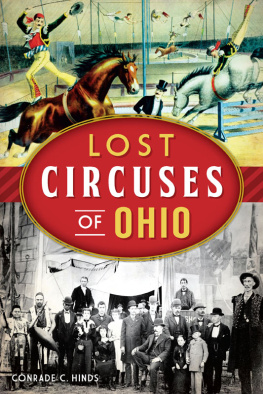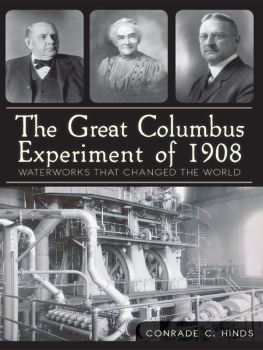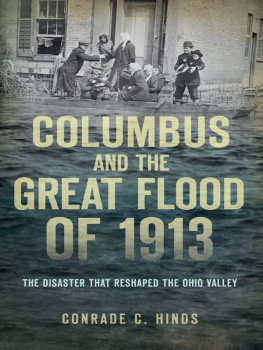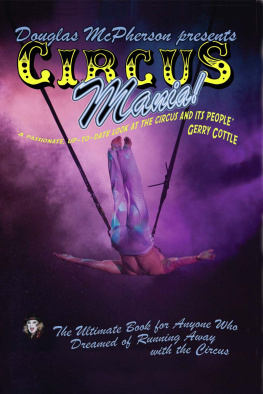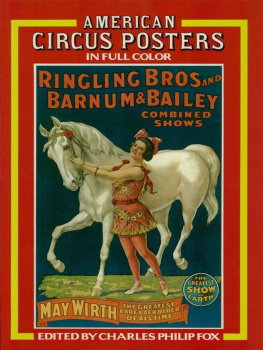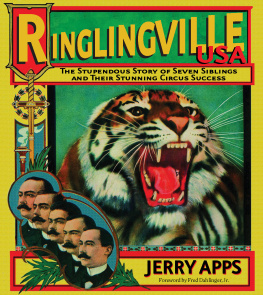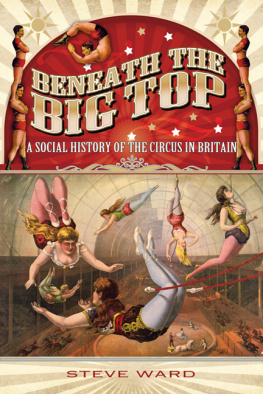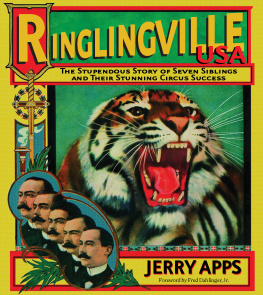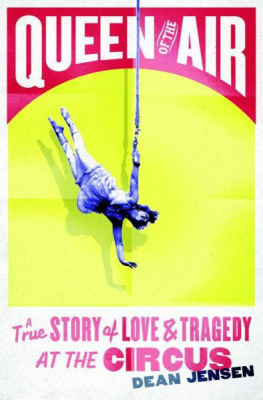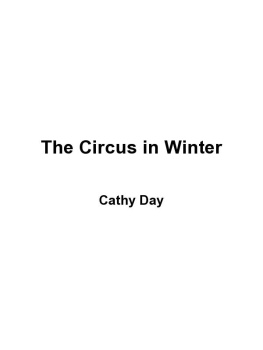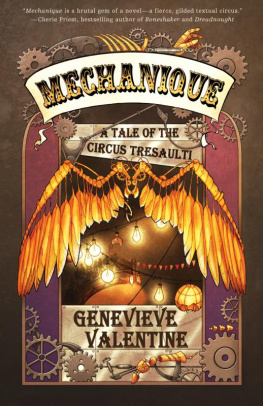

Published by The History Press
Charleston, SC
www.historypress.net
Copyright 2019 by Conrade C. Hinds
All rights reserved
First published 2018
e-book edition 2018
ISBN 978.1.43966.641.8
Library of Congress Control Number: 2018963532
print edition ISBN 978.1.46714.069.0
Notice: The information in this book is true and complete to the best of our knowledge. It is offered without guarantee on the part of the author or The History Press. The author and The History Press disclaim all liability in connection with the use of this book.
All rights reserved. No part of this book may be reproduced or transmitted in any form whatsoever without prior written permission from the publisher except in the case of brief quotations embodied in critical articles and reviews.
This book is dedicated to our grandchildren Audrey, Andromeda, Caleb and Lillian, and all the other grandchildren of my baby-boomer generation. If they cant attend a great circus show, then let them at least be able to read about it and experience the parades and excitement in their imagination.
CONTENTS
PREFACE
My love and interest in the circus began at age three when I started watching a television series called Circus Boy that aired from 1956 to 1958. It was about a twelve-year-old boy name Corky who was adopted by a circus and was a water boy to a baby elephant (he led the elephant to the water). The program shows Corkys participation and involvement in the behind-the-scenes life of the circus. The one thing that I appreciated most was a creed expressed by the talented and diverse circus cast that everyone should be accepted as he or she was born without judgement. That was profound to me because those were the initial years of the civil rights movement. The circus was a pleasant place for everyone and delighted the imagination as well.
This book is about a number of Ohio circuses, big and small, that are a living but forgotten part of our American heritage. I am of the opinion that most great things were invented in Ohio or by an Ohioan. And if neither case applies, then it was improved in Ohio. If that is narrow-minded thinking, then please forgive me, but first check the record. A lot of the modern entertainment world was developed in Ohio. Thomas Edison, who invented motion pictures, was from Ohio. Many of the lithograph billboard posters were printed in Cincinnati and Cleveland. And generations of movie stars, from Lillian Gish to Clark Gable and Dean Martin to Halle Berry, hail from Ohio.
The foundation for much of this entertainment industry started with the Ohio circuses that have been lost over the past century. First, the nineteenthcentury circus yielded to vaudeville. Vaudeville yielded to radio and radio to talking motion pictures. Then along came the television and now computer games and iPads. Our culture gets lost because we are too involved with fads which are short-lived. So we lose a sense of self and our own culture.
The circus still lives even though Ringling is no more. And the lost circuses of Ohio can be found very easily by planting the images into the publics imagination. Today, you can use a computer or iPad to listen to calliope circus music. And since music is able to initiate and preserve emotions, you can close your eyes and be on the midway or in a circus parade down Main Street.
This book is also written as a salute to the Sells brothers (former Union soldiers during the Civil War), who were by all accounts ahead of their time in developing a working community known as Sellsville that was fully integrated by race and class.
ACKNOWLEDGEMENTS
Thank you to Tom Betti and Doreen Uhas Sauer for getting me started as an author of lost and forgotten history. Generous thanks to Fred D. Pfening III for his help in scholarly research, generous sharing of resources and constructive input.
Special thanks to Lenell Nussbaum and Peter Skartvedt, along with Josh and Eleanor Walters, for the use of the pleasant environments of their homes to get this project off the ground. My thanks to the Education Committee of the Columbus Landmarks Foundation for its encouragement and my grateful appreciation to John Sauer for his constructive editing. My gratitude to the many people who are no longer with us for their positive encouragement and how they opened the doors of opportunity for me over the past fifty-plus years.
Special thanks to my wife, Dr. Janet L. Hinds, and my late parents and grandparentsDr. Conrade and Ada Hinds, and Russell and Ethel Davidson, respectivelyfor sharing their insight and wisdom. Id also like to extend my warm acknowledgements to family and friends for their confidence in my ability and many thanks to John Rodrigue of The History Press. And my continued thanks to all those who supported preserving Ohios great heritage of innovation.
INTRODUCTION
OHIOS CONTRIBUTION TO THE NINETEENTH-CENTURY GOLDEN AGE OF THE CIRCUS
Ohio has a strong heritage of being a state of many firsts and many innovations, such as the Wright brothers building the first powered flight airplane and Neil Armstrong being the first to set foot on the moon. The inventive spirit of the traditional Ohioan is rooted in an outstanding group of straightforward problem solvers. In the nineteenth century, Ohio was the American bottleneck, trapped between Canada and the provincial American South. As such, it was Ohio that captured and supplied the needs and wants of the East and West Coasts. It even supplied cities in the South by way of the Ohio and Mississippi Rivers to destinations like Louisville, St. Louis, Memphis and New Orleans.
The mid-nineteenth-century Civil War saw over 650,000 casualties and caused untold misery in the decades to follow. Many communities, especially in the South, had very little to look to for joy, peace and happiness because of the strong alienation that still existed between North and South, displaced relatives, families and the loss of a way of life that disenfranchised so many. Death was always a drink of water away from typhoid fever or dysentery and a host of other waterborne diseases. Also, in many parts of America, most people were still illiterate and lacked access to books or newspapers. There was not very much to really stir ones curiosity or spark a vivid imagination. And it was not uncommon for many people never to travel more than twenty to fifty miles from their place of birth in their entire lifetime.
All of this sets the stage for want and need in a wide range of communities throughout the country. The want was a chance to experience the world and all its profound wonders. The need was to safely have a venue where smiles could repeatedly be put on the faces of children and adults alike.
These needs and wants were filled by greats like James Bailey, Adam Forepaugh and many others. But there were three colossal circuses that served the need to spark and satisfy curiosity and paint a smile on the faces of a postCivil War America. These circuses have been mostly forgotten over time primarily because they were acquired by the twentieth-century circus giant Ringling Bros. and Barnum & Bailey Circus.
In 2017, after 146 years of performing, the Ringling Bros. and Barnum & Bailey Circus announced its closing. The circus was billed as The Greatest Show on Earth and drew large crowds in the twentieth century. But interest in the iconic circus declined with the next century, due to high operating costs and long, costly legal battles with animal rights groups. The shows elephants were retired in May 2016. With the elimination of the elephant act, ticket sales began to decline more significantly. While there were and are today many compassionate animal trainers, historically, much of the animal cruelty was traditionally hidden behind closed doors. The nineteenth-century animal trainer Isaac Van Amburgh was renowned for his use of fear reinforcement. But well talk more about him in the first chapter.
Next page
